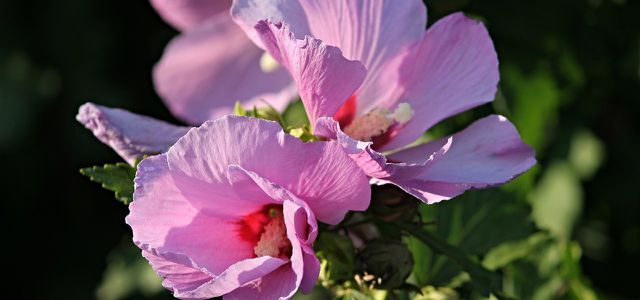
The colorful hibiscus is a popular and robust plant for garden and balcony. You should pay attention to the location, care and pruning.
The hibiscus or marshmallow belongs to the mallow family. Worldwide there are several hundred species in numerous colors and flower shapes. Depending on the species and lifespan, the hibiscus has a different shape and size.
Annual species usually grow shrubby and herbaceous, whereas the perennial varieties can grow to the size of small trees.
All hibiscus species originate from Asia, where they thrive in wild form in subtropical areas.
In our latitudes, the hibiscus is very popular as an indoor or garden plant. The Chinese hibiscus (Hibiscus rosa-sinensis) is often cultivated indoors.
As a garden plant, the hardy garden hibiscus (Hibiscus syriacus) is mainly considered due to the cool temperatures in central European latitudes.
Contents
Location and care of your hibiscus plants

Garden Hibiscus
Garden hibiscus prefers a place sheltered from the wind with direct sunlight. For example, a spot against a warm south-facing wall in the garden or on the balcony is ideal.
Whether you plant your hibiscus directly outdoors or in a container, use a well-drained, not too dry soil with a high nutrient content for the soil. Sandy loamy soil is ideal. The more nutrients your hibiscus’ soil contains, the richer its blooms.
In the summer, you need to water your hibiscus regularly and sufficiently; in dry conditions, the hibiscus will begin to shed its flowers. So the soil may be slightly moist throughout. However, you must be careful not to allow waterlogging to form. This will result in weaker flowers and may even cause the roots to mold.
Indoor hibiscus
For your indoor hibiscus, choose a bright and sunny location. However, you should avoid the blazing midday sun in midsummer. A place at the windowsill is ideal.
Water your hibiscus daily during the summer months and also avoid waterlogging. The Chinese indoor hibiscus does well with normal room temperature. In winter, it likes it a few degrees cooler.
Planting and fertilizing hibiscus: Tips for garden and pot
Garden Hibiscus
Ideally, you should plant a garden hibiscus outdoors in the spring. It does not matter whether it is in a container or in the open ground. It will have enough time to grow roots before its first winter.
Dig a hole twice the size of the root ball and cover the soil with nutrient-rich compost.
Only gently press the soil down after planting so that no roots are injured. A final layer of mulch over the root area will further protect your hibiscus.
Water your hibiscus sufficiently in the first few days. Otherwise, buds that have already set may fall out again.
Fertilize your garden hibiscus only during the summer months. You can use organic flower fertilizer or make your own fertilizer. In winter it does not need any additional fertilizer.
Indoor hibiscus
You should fertilize your indoor hibiscus weekly during the growing season in spring and summer. During the winter months it is sufficient to fertilize it every two to three weeks. If your indoor hibiscus has grown too large over the summer months, it is best to replant it in a larger pot in the spring as well.
Pruning hibiscus for denser growth
Both the garden hibiscus and the indoor hibiscus can be pruned back in spring as needed. Old or dead shoots should be removed completely. All other shoots can be cut back to about five leaf nodes per branch to strengthen the plant. This will shape the plant, allow it to grow more densely and prepare it for re-sprouting.
Keep in mind that the hibiscus is a slow growing plant. Radical pruning at intervals will do the plant good, but it will take a while for it to regain its previous size.
Hibiscus ready overwinter: cool location with light and sun

Most species of garden hibiscus are hardy and survive normal winters in our latitudes well. However, you should protect especially the young plants over the winter outdoors:
To do this, lay a thick mulch layer of fall leaves and brushwood over the plant’s root zone. Layered fir branches are also suitable as protection against the cold.
If your hardy garden hibiscus is in a pot outdoors, make sure that it is especially protected from the wind during the cold season. You can protect it from the cold by placing the pot on an insulating wooden plate.
Indoor hibiscus
Your indoor hibiscus can be left in its original place during the winter months, as long as it is not in the immediate vicinity of a heater. Alternatively, you can move it to a moderately heated room for overwintering. Your hibiscus will be most comfortable in winter at temperatures between 16 and 18 degrees Celsius. A conservatory in these conditions would be ideal. Don’t forget to water it regularly and don’t let the root ball dry out!
And for all hibiscus species, plenty of light and sun is a must, even in winter. A slight loss of leaves over the winter is usually normal. However, if there is a lot of leaf drop, you should inspect the plant for pests and check its location.

